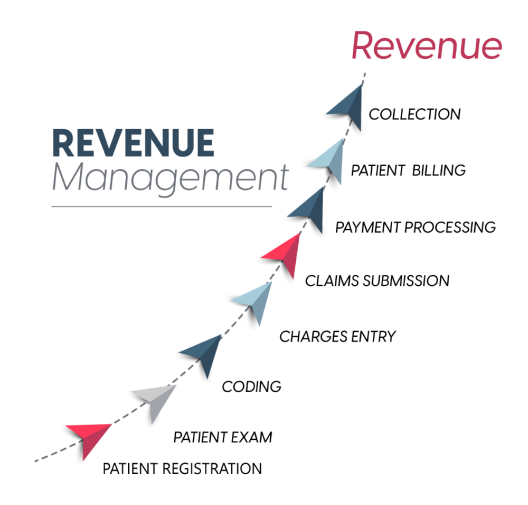We all visit hospitals for various types of care, get treated and get reimbursed for our hospital charges. But do we know what really happens at the back end in this whole healthcare journey? Do we know what processes are followed between we submit our bills and get it reimbursed? The answer would be predominantly – NO.
This article is the first part that helps you understand the chain of activities that happen from the time we visit a healthcare provider for our care, get admitted into a hospital till the hospital receives its payment for their services. These activities are summed up to be called the Revenue Cycle Management.

Stakeholders and their Roles
There are 3 main stakeholders to the RCM process – Patient, Healthcare Provider and Healthcare Payer.
- Patients register themselves with the hospital, get treated according to the insurance plan they are enrolled in and get reimbursed for their medical cost.
- Providers provide medical services to the patient, submit medical bills to the insurers and get reimbursed for their services.
- Payers are the people who pay for the healthcare services. They take in the medical claims, evaluate it, and reimburse the hospitals depending on the policy rules.
Types of Payers
Payers are of 2 types – private and public or the government-run.
In the US, there is a huge government-run centre called the CMS, The Centres for Medicare and Medicaid Services which provides health coverage to more than 100 million people through various schemes such as Medicare, Medicaid, Children’s Health Insurance Program, etc. which caters to the elderly, low-income groups, children, retired military people, and so on. Key private insurance companies of US would be Cigna, Humana, Blue Cross Blue Shield, among others.
Similarly, in India, we have government-run healthcare schemes such as Ayushman Bharat Yojana, Pradhan Mantri Suraksha Bima Yojana, Aam Aadmi Bima Yojana (AABY) and so on which cater to diverse group of people. Some key players in private health insurance sector would be Star Health and Allied Insurance, Bajaj Allianz General Insurance, ICICI Lombard Health Insurance, among others.
Revenue Cycle Management Market in terms of revenue was estimated to be worth $49.6 billion in 2023 and is poised to reach $84.1 billion by 2028, growing at a CAGR of 11.1% from 2023 to 2028 according to a new report. In 2022, North America held the largest market share for revenue cycle management.
Insurance, ICICI Lombard Health Insurance, among others.
The Process
The RCM process comprises of 3 major categories of activities – Front office, Claims office, and Back office.
Front Office
The front office plays a role when the patient calls the hospital for an appointment or pre-registration. The front office performs activities such as taking in the details of patient, details of ailment, medical history, checking their insurance details and their eligibility of medical coverage.
The front office also analyzes the various components and benefits covered under an insurance plan such as pre-ailment coverage, room rent entitlements, ambulance cost coverage, co-pay, deductibles, co-insurance, etc.
Then the patient meets with the doctor, disease is diagnosed, and treatment plan is decided. Before starting the treatment, the hospital must do a pre-authorization check. Pre-authorization is a key step in RCM where the hospital checks with the insurance company if the proposed treatment is covered under the medical plan the patient is enrolled in.
After getting the necessary approvals from the insurance company, the patient’s admission, treatment, medical intervention, procedure happens one after the other and the patient is discharged.

Claims Office
Now, the claims office’s crucial role begins. They have to submit the medical documents or medical claim to the payer to get reimbursed. In this process, they perform Medical Coding, which is again a crucial process in RCM where every step of the patient’s medical activity is coded as per the medical coding standards ICD and CPT.
The procedure, diagnosis, treatment given, tests performed, surgical instruments used are assigned a code followed by an activity called the Charge Entry, where all these codes are converted into a value which sums up to a medical cost of the services provided to the patient.
Before submitting the medical claim to the payer, another key activity called the Claims Scrubbing happens, where the claim is thoroughly scrutinized by the claims department as final check before submission. Claim scrubbing is the process of scanning the practice’s medical claims for errors that would cause payers (i.e., insurance companies) to deny the claim.
Once, the claims are submitted, the role of payer or the insurer starts with Claims Processing. The payer analyzes the claim, validates the documents submitted for accuracy, adequate information, and authenticity. At the end of this process, the insurance company may reimburse the money to the healthcare provider in whole or in part. The company may also reject the claim request, if found duplicated, invalid, forged, or outside of the policy terms.
The decision-making activity of the payer whether to reimburse the claims, how much to reimburse, etc. is called the Claims Adjudication. Insurance companies use a combination of automated and manual verification for the adjudication of claims. Based on the claim adjudication, the insurance company reimburses an amount to the hospital.
The insurance company also sends a notification known as an explanation of benefits (EOB) which includes details of the claim amount paid, amount not paid, reasoning for each of these, patient responsibility amount (in cases of co-pay or co-insurance), covered amount, discount amount and so on. For the amount paid, the payer also sends an Electronic Remittance Advice (ERA) which details out the break-up of the amount reimbursed, denied amount, etc.
As a final step to the RCM process, the insurance company settles the amount that it is due to pay the healthcare provider for the treatment rendered to the insured patient.
If claims are denied, the provider interacts with the payer to know the reason for denial and the patient to get the required documents/information for resubmissions. Denial Management is a stream of work by itself in the RCM process which includes appeals, resubmissions, and resolutions.
International Classification of Disease (ICD) is a morbidity classification published by the United States for classifying diagnoses and reason for visits in all health care settings.
Current Procedural Terminology (CPT) is a uniform language for coding medical services and procedures to streamline reporting, increase accuracy and efficiency.
Source: Wikipedia

Author
S Rajeswari
Rajeswari is part of the Presales team at GAVS. She has been involved in technical and creative content development for the past 15 years. She is passionate about learning new technologies, gardening, music and writing. She spends her free time watching movies or going for a highway drive.




